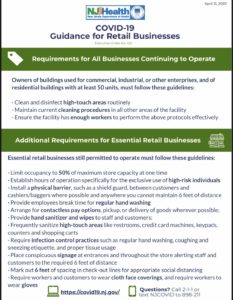Landscape, Ornamentals, Nursery, and Turf Edition
Seasonal updates on ornamental, nursery, and turf pests.
Subscriptions are available via EMAIL and RSS.
Companion Website Links:
 Rutgers Turf Blog - Articles on turfgrass diseases and cultural practices for the commercial turfgrass industry. Subscription available via RSS.
Rutgers Turf Blog - Articles on turfgrass diseases and cultural practices for the commercial turfgrass industry. Subscription available via RSS.
 Rutgers Weather Forecasting - Meteorological Information important to commercial agriculture.
Rutgers Weather Forecasting - Meteorological Information important to commercial agriculture.
EPA Releases Temporary Guidance on Respiratory Protection for Agricultural Pesticide Handlers During COVID-19
Hand Sanitizers for Use in the Field
Under the “Interim COVID-19 Guidance for Migrant and Seasonal Farmworkers, Their Employers, and Housing Providers”, employers are required to provide hand sanitizers with at least 60-95% alcohol in various locations and employers are to schedule handwashing breaks every hour. If soap and water are not available, an alcohol-based sanitizer that contains 60-95% alcohol may be used. Hand sanitizers may be difficult to find, but a grower can make their own. Visit the onfarmfoodsafety.rutgers.edu website for a factsheet entitled “Home-made Hand Sanitizer”. This walks you through how to make a cheap effective sanitizer.
The next question is, what is the proper method to apply and use the sanitizer? Research has shown that a two-step sanitizer method is the best method for alcohol-based sanitizers.
- Step 1: Apply three pumps of sanitizer from the dispenser.
- Step 2: Rub hands for 20 seconds making sure to cover the palms, backs of hands, and between fingers up to the wrists.
- Step 3: Wipe the hands on a disposable paper towel.
- Step 4: Apply one pump of the sanitizer from the dispenser.
- Step 5: Rub hands until dry.
Hand sanitizers do not take the place of handwashing before starting or returning to work; after using the toilet; before and after eating and smoking; before putting on gloves; after touching animals or animal waste or any other time hands may become contaminated under the Food Safety Modernization Act or for most audits.
Signage for Farm Worker COVID-19 Education Available
NJ Secretary of Agriculture Douglas Fisher has requested the following message be shared with the farm community.
To assist farm operators in the provision of COVID-19 education, the NJ Department of Health has created a set of prevention messages that can be used as signage to be hung in common areas on farms. [Read more…]
Cloth Face Covering Requirements for Customers and Employees
 As farms start-up their pick-your-own seasons we are becoming more aware of negative customer feedback on social media sites. Comments have mostly been specific to the requirement of customers wearing face coverings while outside at a farm retail business. Your farm is deemed an “essential retail business” allowing you to be open, but requiring you to follow state guidelines. Customers are required to wear cloth face coverings at all times while at any essential retail business, including farm markets, farm stands, and pick-your-own locations. Those with health conditions where a face covering would cause a negative impact on their health and children under the age of two are exempted from this requirement. This season will be unlike any other you have had at the farm, and your customers experience will be different than what they are used to. This season your farm has the opportunity to provide a safe place to obtain local, healthy food, and hopefully they will make a few good memories while practicing social distancing and using face coverings appropriately.
As farms start-up their pick-your-own seasons we are becoming more aware of negative customer feedback on social media sites. Comments have mostly been specific to the requirement of customers wearing face coverings while outside at a farm retail business. Your farm is deemed an “essential retail business” allowing you to be open, but requiring you to follow state guidelines. Customers are required to wear cloth face coverings at all times while at any essential retail business, including farm markets, farm stands, and pick-your-own locations. Those with health conditions where a face covering would cause a negative impact on their health and children under the age of two are exempted from this requirement. This season will be unlike any other you have had at the farm, and your customers experience will be different than what they are used to. This season your farm has the opportunity to provide a safe place to obtain local, healthy food, and hopefully they will make a few good memories while practicing social distancing and using face coverings appropriately.
We have gathered resources to help convey the Governors Executive Orders, and their impacts to your farm operation, below. The second link is the newly released NJDH printable poster outlining the requirements of all businesses allowed to operate during this time, including the mandate all operating businesses require customers and employees to wear face coverings.
NJ Executive Order 122 – Full length (see page 6, letter K for specifics)
“Require workers and customers to wear cloth face coverings while on the premises, except where doing so would inhibit that individuals health or where the individual is under two years of age.”
NJDH Guidance for Retail Businesses – Requirements for all Businesses Continuing to Operate (printable poster)
“Require workers and customers to wear cloth face coverings, and require workers to wear gloves.”
NJDH/NJDA/DOL Guidance for Migrant and Seasonal Farmworkers, Their Employers, and Housing Providers
“Workers must wear face coverings at all times, including during transportation, while working, and while in the presence of others.”
Specialty Crops Producers Can Now Apply for Financial Assistance Through USDA’s Coronavirus Food Assistance Program
USDA Agricultural Marketing Service sent this bulletin at 05/26/2020 03:31 PM EDT
 WASHINGTON, May 26, 2020-–Specialty crops producers can now apply for USDA’s Coronavirus Food Assistance Program (CFAP), which provides direct payments to offset impacts from the coronavirus pandemic. The application and a payment calculator are now available online and USDA’s Farm Service Agency (FSA) staff members are available via phone, fax and online tools to help producers complete applications. The agency set up a call center in order to simplify how they serve new customers across the nation. Applications will be accepted through August 28, 2020.
WASHINGTON, May 26, 2020-–Specialty crops producers can now apply for USDA’s Coronavirus Food Assistance Program (CFAP), which provides direct payments to offset impacts from the coronavirus pandemic. The application and a payment calculator are now available online and USDA’s Farm Service Agency (FSA) staff members are available via phone, fax and online tools to help producers complete applications. The agency set up a call center in order to simplify how they serve new customers across the nation. Applications will be accepted through August 28, 2020.
Through CFAP, USDA is making available $16 billion for vital financial assistance to producers of agricultural commodities who have suffered a five-percent-or-greater price decline due to COVID-19 and face additional significant marketing costs as a result of lower demand, surplus production, and disruptions to shipping patterns and the orderly marketing of commodities.
We also want to remind producers that the program is structured to ensure the availability of funding for all eligible producers who apply. In order to do this, producers will receive 80 percent of their maximum total payment upon approval of the application. The remaining portion of the payment, not to exceed the payment limit, will be paid at a later date nationwide, as funds remain available.
Producers can download the CFAP application and other eligibility forms from farmers.gov/cfap. Also, on that webpage, producers can find a payment calculator to help identify sales and inventory records needed to apply and calculate potential payments.
Additionally, producers in search of one-on-one support with the CFAP application process can call 877-508-8364 to speak directly with a USDA employee ready to offer assistance. This is a good first step before a producer engages the team at the FSA county office at their local USDA Service Center.
Applying for Assistance
Producers of all eligible commodities will apply through their local FSA office. Those who use the online calculator tool will be able to print off a pre-filled CFAP application to sign and submit to your local FSA office either electronically or via hand delivery. Please contact your local office to determine the preferred method. Producers can find contact information for their FSA county office by visiting farmers.gov/CFAP and using the Find Your Local Service Center tool at the bottom of the page.
Documentation to support the producer’s application and certification may be requested after the application is filed. FSA has streamlined the signup process to not require an acreage report at the time of application and a USDA farm number may not be immediately needed.
Additional Commodities
USDA is also establishing a process for the public to identify additional commodities for potential inclusion in CFAP. Specifically, USDA is looking for data on agricultural commodities, that are not currently eligible for CFAP, that the public believes to have either:
- suffered a five percent-or-greater price decline between mid-January and mid-April as a result of the COVID-19 pandemic,
- shipped but subsequently spoiled due to loss of marketing channel, or
- not left the farm or remained unharvested as mature crops.
More information about this process is available on farmers.gov/cfap.
More Information
To find the latest information on CFAP, visit farmers.gov/cfap or call 877-508-8364.
USDA Service Centers are open for business by phone appointment only, and field work will continue with appropriate social distancing. While program delivery staff will continue to come into the office, they will be working with producers by phone and using online tools whenever possible. All Service Center visitors wishing to conduct business with the FSA, Natural Resources Conservation Service, or any other Service Center agency are required to call their Service Center to schedule a phone appointment. More information can be found at farmers.gov/coronavirus.
###
Last “Ask the Ag Agent” Webinar Tonight at 7:00PM
The last springtime Rutgers Cooperative Extension, “Ask the Ag Agent” weekly 1-hour sessions for farmers will take place tonight 5/27/20 at 7:00PM. We realize the season is well underway and most farmers are out in the fields. With the regular sessions ending for now, please reach out to your local County Agricultural Agent at anytime for assistance. We are open for business, and as times have changed we have changed with them.
This last online webinar/call in event will begin promptly at 7:00PM with an open forum to discuss ag-related questions about production, marketing, regulations and any other topics farmers wish to discuss.
Thank you to all who joined each week over the past two months and thank you to the Ag Agents and Extension Specialists who have participated. Bill Bamka, Stephen Komar, Meredith Melendez and Michelle Infante-Casella created and hosted this forum one week after the State of NJ went into lockdown and it has been quite the journey. Please join us for one last session for spring. All are welcome.
To access via WebEx on a computer go to https://go.rutgers.edu/rc9n3kxt
Join by phone
+1-650-429-3300 USA Toll
Access code: 799 743 872 # and then # again to join

